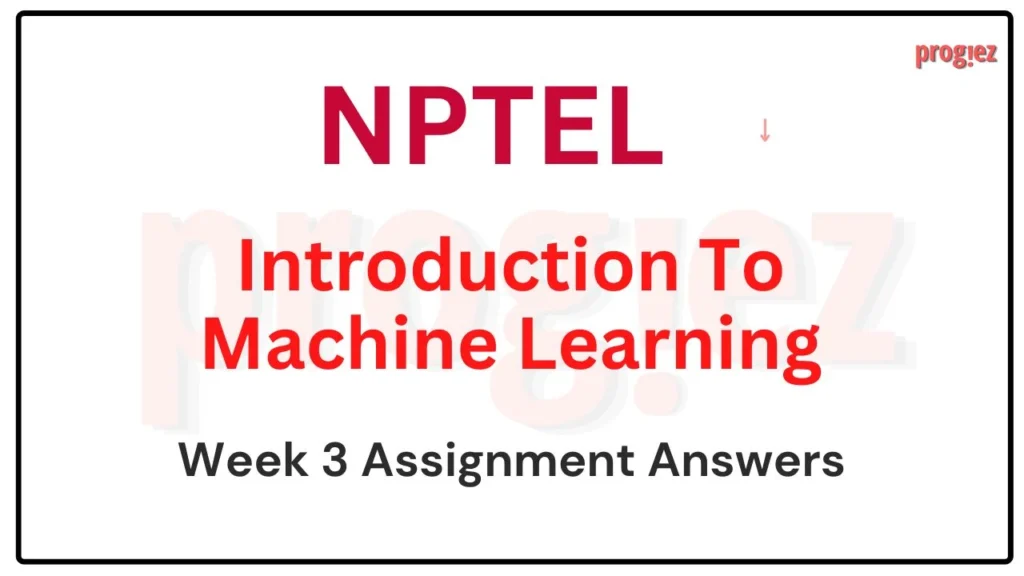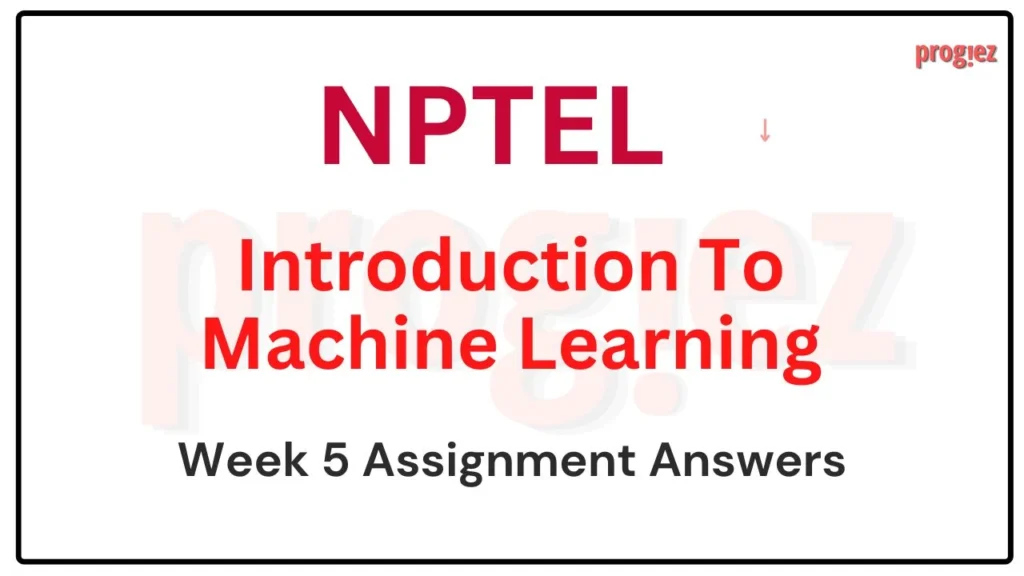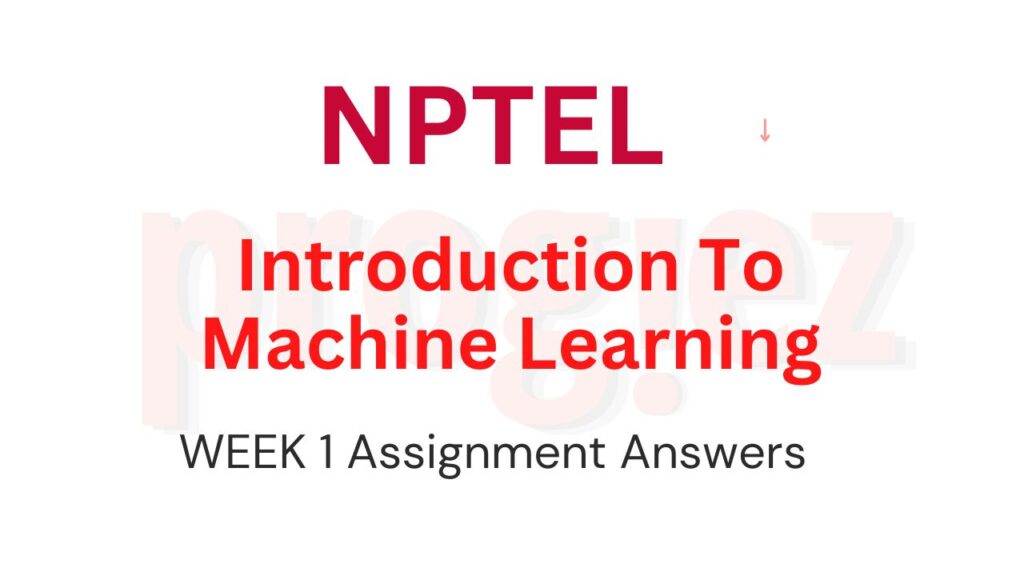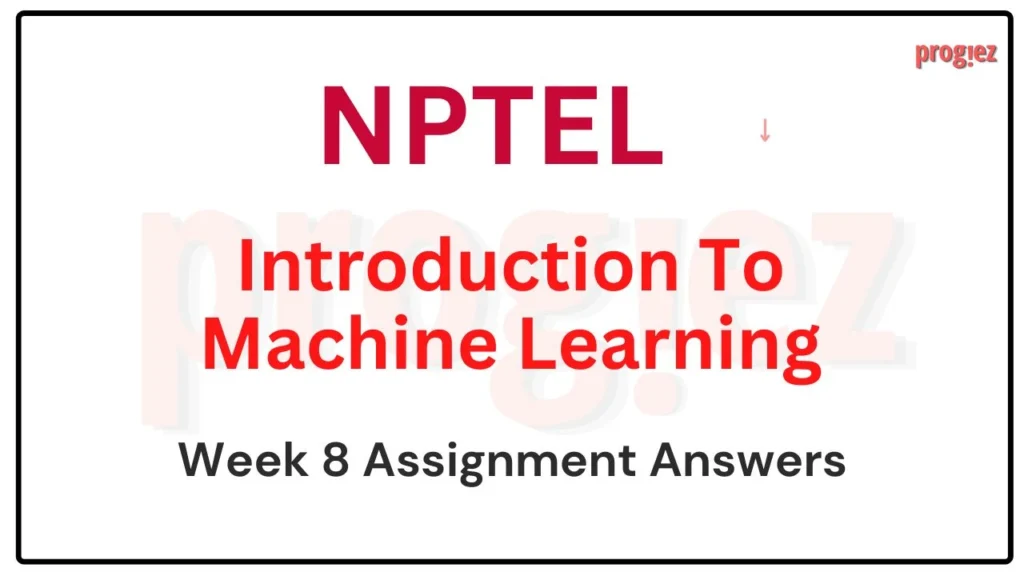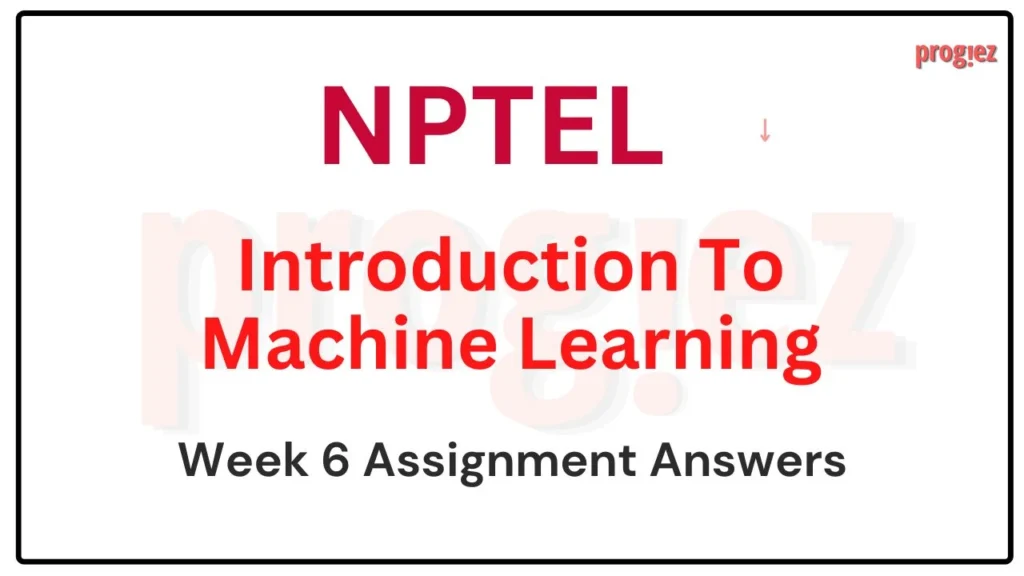Introduction to Machine Learning Nptel Week 2 Answers
Are you looking for Introduction to Machine Learning Nptel Week 2 Answers? You’ve come to the right place! Access the latest and most accurate solutions for your Week 2 assignment in the Introduction to Machine Learning course.
Course Link: Click Here
Table of Contents
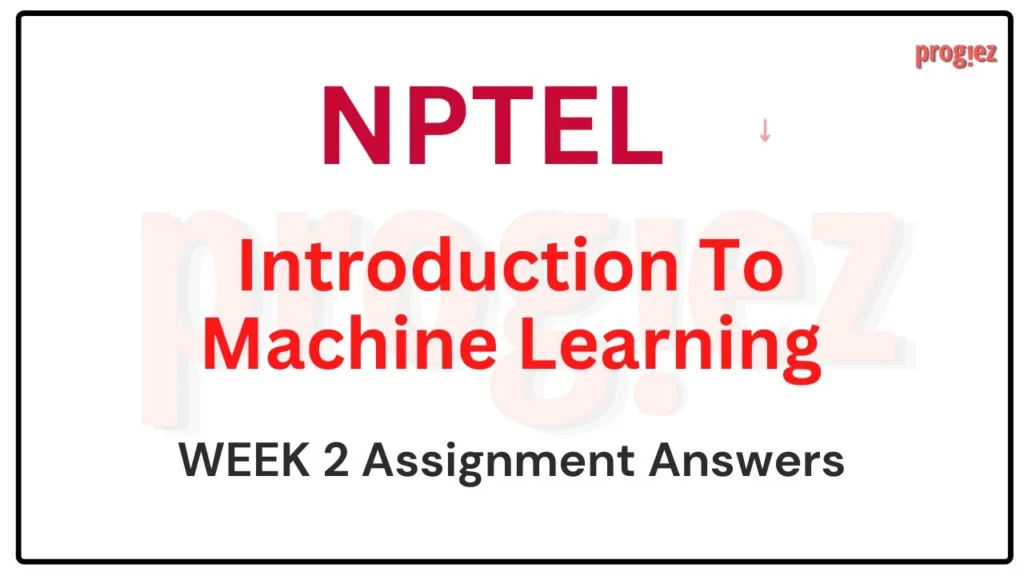
Introduction to Machine Learning Nptel Week 2 Answers (July-Dec 2024)
Q1.State True or False:
Typically, linear regression tend to underperform compared to k-nearest neighbor algorithms when dealing with high-dimensional input spaces.
True
False
Answer: True
Q2. Given the following dataset, find the uni-variate regression function that best fits the dataset.
f(x)=1×x+4
f(x)=1×x+5
f(x)=1.5×x+3
f(x)=2×x+1
Answer: f(x)=1.5×x+3
For answers or latest updates join our telegram channel: Click here to join
These are Introduction to Machine Learning Nptel Week 2 Answers
Q3.Given a training data set of 500 instances, with each input instance having 6 dimensions and each output being a scalar value, the dimensions of the design matrix used in applying linear regression to this data is
500×6
500×7
500×62
None of the above
Answer: 500×7
Q4. Assertion A: Binary encoding is usually preferred over One-hot encoding to represent categorical data (eg. colors, gender etc)
Reason R: Binary encoding is more memory efficient when compared to One-hot encoding
Both A and R are true and R is the correct explanation of A
Both A and R are true but R is not the correct explanation of A
A is true but R is false
A is false but R is true
Answer: Both A and R are true and R is the correct explanation of A
For answers or latest updates join our telegram channel: Click here to join
These are Introduction to Machine Learning Nptel Week 2 Answers
Q5. Select the TRUE statement
Subset selection methods are more likely to improve test error by only focussing on the most important features and by reducing variance in the fit.
Subset selection methods are more likely to improve train error by only focussing on the most important features and by reducing variance in the fit.
Subset selection methods are more likely to improve both test and train error by focussing on the most important features and by reducing variance in the fit.
Subset selection methods don’t help in performance gain in any way.
Answer: Subset selection methods are more likely to improve test error by only focussing on the most important features and by reducing variance in the fit.
Q6. Rank the 3 subset selection methods in terms of computational efficiency:
Forward stepwise selection, best subset selection, and forward stagewise regression.
Forward stepwise selection, forward stagewise regression and best subset selection.
Best subset selection, forward stagewise regression and forward stepwise selection.
Best subset selection, forward stepwise selection and forward stagewise regression.
Answer: Forward stepwise selection, forward stagewise regression and best subset selection.
For answers or latest updates join our telegram channel: Click here to join
These are Introduction to Machine Learning Nptel Week 2 Answers
Q7.Choose the TRUE statements from the following: (Multiple correct choice)
Ridge regression since it reduces the coefficients of all variables, makes the final fit a lot more interpretable.
Lasso regression since it doesn’t deal with a squared power is easier to optimize than ridge regression.
Ridge regression has a more stable optimization than lasso regression.
Lasso regression is better suited for interpretability than ridge regression.
Answer: Ridge regression has a more stable optimization than lasso regression.
Lasso regression is better suited for interpretability than ridge regression.
Q8.Which of the following statements are TRUE? Let xi be the i−th datapoint in a dataset of N
points. Let v represent the first principal component of the dataset. (Multiple answer questions)
a) v=argmax∑Ni=1(vTxi)2s.t.|v|=1
b) v=argmin∑Ni=1(vTxi)2s.t.|v|=1
c) Scaling at the start of performing PCA is done just for better numerical stability and computational benefits but plays no role in determining the final principal components of a dataset.
d) The resultant vectors obtained when performing PCA on a dataset can vary based on the scale of the dataset.
Answer: a),d)
For answers or latest updates join our telegram channel: Click here to join
These are Introduction to Machine Learning Nptel Week 2 Answers
All weeks of Introduction to Machine Learning: Click Here
For answers to additional Nptel courses, please refer to this link: NPTEL Assignment Answers
Introduction to Machine Learning Nptel Week 2 Answers (JAN-APR 2024)
Course Link: Click Here
For answers or latest updates join our telegram channel: Click here to join
These are Introduction to Machine Learning Week 2 Assignment 2 Answers
Q1. The parameters obtained in linear regression
can take any value in the real space
are strictly integers
always lie in the range [0,1]
can take only non-zero values
Answer: can take any value in the real space
Q2. Suppose that we have N independent variables (X1,X2,…Xn) and the dependent variable is Y. Now imagine that you are applying linear regression by fitting the best fit line using the least square error on this data. You found that the correlation of X1 with Y is -0.005.
Regressing Y on X1 mostly does not explain away Y
Regressing Y on X1 explains away Y
The given data is insufficient to determine if regressing Y on X1 explains away Y or not
None of the above
Answer: Regressing Y on X1 mostly does not explain away Y
For answers or latest updates join our telegram channel: Click here to join
These are Nptel Introduction to Machine Learning Week 2 Assignment Answers
Q3. The relation between studying time (in hours) and grade on the final examination (0-100) in a random sample of students in the Introduction to Machine Learning Class was found to be:
Grade = 30.5+15.2(h)
How will a student’s grade be affected if she studies for four hours, compared to not studying?
It will go down by 30.4 points
It will go up by 60.8 points
The grade will remain unchanged
It cannot be determined from the information given
Answer: It will go up by 60.8 points
Q4. Consider the following 4 training examples:
We want to learn a function f(x)=ax+b which is parametrized by (a,b). Using squared error as the loss function, which of the following parameters would you use to model this function.
(1,1)
(1,2)
(2,1)
(2,2)
Answer: (1,1)
For answers or latest updates join our telegram channel: Click here to join
These are Nptel Introduction to Machine Learning Week 2 Assignment Answers
Q5. Consider a modified k−NN method in which once the k nearest neighbours to the query point are identified, you do a linear regression fit on them and output the fitted value for the query point. Which of the following is/are true regarding this method.
This method makes an assumption that the data is locally linear
In order to perform well, this method would need dense distributed training data
This method has higher bias compared to k−NN
This method has higher variance compared to k−NN
Answer: a, b, d
This method makes an assumption that the data is locally linear
In order to perform well, this method would need dense distributed training data
This method has higher variance compared to k−NN
Q6. Which of the statements is/are True?
Ridge has sparsity constraint, and it will drive coefficients with low values to 0
Lasso has a closed form solution for the optimization problem, but this is not the case for Ridge
Ridge regression may reduce the number of variables
If there are two or more highly collinear variables, Lasso will select one of them randomly
Answer: c, d
Ridge regression does not reduce the number of variables since it never leads a coefficient to zero but only minimizes it.
If there are two or more highly collinear variables, Lasso will select one of them randomly
For answers or latest updates join our telegram channel: Click here to join
These are Nptel Introduction to Machine Learning Week 2 Assignment Answers
Q7. Choose the correct option(s) from the following:
When working with a small dataset, one should prefer low bias/high variance classifiers over high bias/low variance classifiers
When working with a small dataset, one should prefer high bias/low variance classifiers over low bias/high variance classifiers
When working with a large dataset, one should prefer high bias/low variance classifiers over low bias/high variance classifiers
When working with a large dataset, one should prefer low bias/high variance classifiers over high bias/low variance classifiers
Answer: b), d)
When working with a small dataset, one should prefer high bias/low variance classifiers over low bias/high variance classifiers
When working with a large dataset, one should prefer low bias/high variance classifiers over high bias/low variance classifiers
Q8. Consider the following statements:
Statement A: In Forward stepwise selection, in each step, that variable is chosen which has the maximum correlation with the residual, then the residual is regressed on that variable, and it is added to the predictor.
Statement B: In Forward stagewise selection, the variables are added one by one to the previously selected variables to produce the best fit till then
Both the statements are True
Statement A is True, and Statement B is False
Statement A if False and Statement B is True
Both the statements are False
Answer: Both the statements are False
For answers or latest updates join our telegram channel: Click here to join
These are Nptel Introduction to Machine Learning Week 2 Assignment Answers
Q9. The linear regression model y=a0+a1x1+a2x2+…+apxp is to be fitted to a set of N training data points having p attributes each. Let X be N×(p+1) vectors of input values (augmented by 1’s), Y be N×1
vector of target values, and θ be (p+1)×1 vector of parameter values (a0,a1,a2,…,ap ). If the sum squared error is minimized for obtaining the optimal regression model, which of the following equation holds?
XTX=XY
Xθ=XTY
XTXθ=Y
XTXθ=XTY
Answer: XTXθ=XTY
For answers or latest updates join our telegram channel: Click here to join
These are Nptel Introduction to Machine Learning Week 2 Assignment Answers
More Weeks of Introduction to Machine Learning: Click here
More Nptel Courses: https://progiez.com/nptel-assignment-answers
Introduction to Machine Learning Nptel Week 2 Answers (JULY-DEC 2023)
Course Link: Click Here
These are Introduction to Machine Learning Week 2 Assignment 2 Answers
Q1. The parameters obtained in linear regression
can take any value in the real space
are strictly integers
always lie in the range [0,1]
can take only non-zero values
Answer: can take any value in the real space
These are Nptel Introduction to Machine Learning Week 2 Assignment Answers
Q2. Suppose that we have N independent variables (X1,X2,…Xn) and the dependent variable is Y. Now imagine that you are applying linear regression by fitting the best fit line using the least square error on this data. You found that the correlation coefficient for one of its variables (Say X1) with Y is -0.005.
Regressing Y on X1 mostly does not explain away Y.
Regressing Y on X1 explains away Y.
The given data is insufficient to determine if regressing Y on X1 explains away Y or not.
Answer: Regressing Y on X1 mostly does not explain away Y.
These are Nptel Introduction to Machine Learning Week 2 Assignment Answers
Q3. Which of the following is a limitation of subset selection methods in regression?
They tend to produce biased estimates of the regression coefficients.
They cannot handle datasets with missing values.
They are computationally expensive for large datasets.
They assume a linear relationship between the independent and dependent variables.
They are not suitable for datasets with categorical predictors.
Answer: They are computationally expensive for large datasets.
These are Nptel Introduction to Machine Learning Week 2 Assignment Answers
Q4. The relation between studying time (in hours) and grade on the final examination (0-100) in a random sample of students in the Introduction to Machine Learning Class was found to be:Grade = 30.5 + 15.2 (h)
How will a student’s grade be affected if she studies for four hours?
It will go down by 30.4 points.
It will go down by 30.4 points.
It will go up by 60.8 points.
The grade will remain unchanged.
It cannot be determined from the information given
Answer: It will go up by 60.8 points.
These are Nptel Introduction to Machine Learning Week 2 Assignment Answers
Q5. Which of the statements is/are True?
Ridge has sparsity constraint, and it will drive coefficients with low values to 0.
Lasso has a closed form solution for the optimization problem, but this is not the case for Ridge.
Ridge regression does not reduce the number of variables since it never leads a coefficient to zero but only minimizes it.
If there are two or more highly collinear variables, Lasso will select one of them randomly
Answer: a, d
These are Nptel Introduction to Machine Learning Week 2 Assignment Answers
Q6. Find the mean of squared error for the given predictions:
Hint: Find the squared error for each prediction and take the mean of that.
1
2
1.5
0
Answer: 1
These are Nptel Introduction to Machine Learning Week 2 Assignment Answers
Q7. Consider the following statements:
Statement A: In Forward stepwise selection, in each step, that variable is chosen which has the maximum correlation with the residual, then the residual is regressed on that variable, and it is added to the predictor.
Statement B: In Forward stagewise selection, the variables are added one by one to the previously selected variables to produce the best fit till then
Both the statements are True.
Statement A is True, and Statement B is False
Statement A is False and Statement B is True
Both the statements are False.
Answer: Both the statements are False.
These are Nptel Introduction to Machine Learning Week 2 Assignment Answers
Q8. The linear regression model y=a0+a1x1+a2x2+…+apxp is to be fitted to a set of N training data points having p attributes each. Let X be N×(p+1) vectors of input values (augmented by 1‘s), Y be N×1
vector of target values, and θ be (p+1)×1 vector of parameter values (a0,a1,a2,…,ap). If the sum squared error is minimized for obtaining the optimal regression model, which of the following equation holds?
XTX=XY
Xθ=XTY
XTXθ=Y
XTXθ=XTY
Answer: D. XTXθ=XTY
These are Nptel Introduction to Machine Learning Week 2 Assignment Answers
Q9. Which of the following statements is true regarding Partial Least Squares (PLS) regression?
PLS is a dimensionality reduction technique that maximizes the covariance between the predictors and the dependent variable.
PLS is only applicable when there is no multicollinearity among the independent variables.
PLS can handle situations where the number of predictors is larger than the number of observations.
PLS estimates the regression coefficients by minimizing the residual sum of squares.
PLS is based on the assumption of normally distributed residuals.
All of the above.
None of the above.
Answer: PLS is a dimensionality reduction technique that maximizes the covariance between the predictors and the dependent variable.
These are Nptel Introduction to Machine Learning Week 2 Assignment Answers
Q10. Which of the following statements about principal components in Principal Component Regression (PCR) is true?
Principal components are calculated based on the correlation matrix of the original predictors.
The first principal component explains the largest proportion of the variation in the dependent variable.
Principal components are linear combinations of the original predictors that are uncorrelated with each other.
PCR selects the principal components with the highest p-values for inclusion in the regression model.
PCR always results in a lower model complexity compared to ordinary least squares regression.
Answer: Principal components are linear combinations of the original predictors that are uncorrelated with each other.
These are Nptel Introduction to Machine Learning Week 2 Assignment Answers
More Weeks of INTRODUCTION TO MACHINE LEARNING: Click here
More Nptel Courses: Click here
Introduction to Machine Learning Nptel Week 2 Answers (JAN-APR 2023)
Course Link: Click Here
These are Nptel Introduction to Machine Learning Week 2 Assignment Answers
Q1. Given a training data set of 10,000 instances, with each input instance having 17 dimensions and each output instance having 2 dimensions, the dimensions of the design matrix used in applying linear regression to this data is
a. 10000 × 17
b. 10002 × 17
c. 10000 × 18
d. 10000 × 19
Answer: c. 10000 × 18
These are Nptel Introduction to Machine Learning Week 2 Assignment Answers
Q2. Suppose we want to add a regularizer to the linear regression loss function, to control the magnitudes of the weights β. We have a choice between Ω1(β)=Σpi=1|β| and Ω2(β)=Σpi=1β2. Which one is more likely to result in sparse weights?
a. Ω1
b. Ω2
c. Both Ω1 and Ω2 will result in sparse weights
d. Neither of Ω1 or Ω2 can result in sparse weights
Answer: a. Ω1
These are Introduction to Machine Learning Week 2 Assignment 2 Answers
Q3. The model obtained by applying linear regression on the identified subset of features may differ from the model obtained at the end of the process of identifying the subset during
a. Forward stepwise selection
b. Backward stepwise selection
c. Forward stagewise selection
d. All of the above
Answer: c. Forward stagewise selection
These are Nptel Introduction to Machine Learning Week 2 Assignment Answers
Q4. Consider forward selection, backward selection and best subset selection with respect to the same data set. Which of the following is true?
a. Best subset selection can be computationally more expensive than forward selection
b. Forward selection and backward selection always lead to the same result
c. Best subset selection can be computationally less expensive than backward selection
d. Best subset selection and forward selection are computationally equally expensive
e. Both (b) and (d)
Answer: a. Best subset selection can be computationally more expensive than forward selection
These are Introduction to Machine Learning Week 2 Assignment 2 Answers
Q5. In the lecture on Multivariate Regression, you learn about using orthogonalization iteratively to obtain regression co-effecients. This method is generally referred to as Multiple Regression using Successive Orthogonalization. In the formulation of the method, we observe that in iteration k, we regress the entire dataset on z0,z1,…zk−1. It seems like a waste of computation to recompute the coefficients for z0 a total of p times, z1 a total of p−1 times and so on. Can we re-use the coefficients computed in iteration j for iteration j+1 for zj−1?
a. No. Doing so will result in the wrong γ matrix. and hence, the wrong βi’s.
b. Yes. Since zj−1 is orthogonal to zj−l∀l≤j1, the multiple regression in each iteration is essentially a univariate regression on each of the previous residuals. Since the regression coefficients for the previous residuals don’t change over iterations, we can re-use the coefficients for further iterations.
Answer: b. Yes. Since zj−1 is orthogonal to zj−l∀l≤j1, the multiple regression in each iteration is essentially a univariate regression on each of the previous residuals. Since the regression coefficients for the previous residuals don’t change over iterations, we can re-use the coefficients for further iterations.
These are Nptel Introduction to Machine Learning Week 2 Assignment Answers
Q6. Principal Component Regression (PCR) is an approach to find an orthogonal set of basis vectors which can then be used to reduce the dimension of the input. Which of the following matrices contains the principal component directions as its columns (follow notation from the lecture video)
a. X
b. S
c. Xc
d. V
e. U
Answer: d. V
These are Nptel Introduction to Machine Learning Week 2 Assignment Answers
Q7. Consider the following five training examples
We want to learn a function f(x) of the form f(x)=ax+b which is parameterised by (a,b). Using squared error as the loss function, which of the following parameters would you use to model this function to get a solution with the minimum loss.
a. (4,3)
b. (1,4)
c. (4,1)
d. (3,4)
Answer: d. (3,4)
These are Nptel Introduction to Machine Learning Week 2 Assignment Answers
Q8. Here is a data set of words in two languages.
Let us build a nearest neighbours classifier that will predict which language a word belongs to. Say we represent each word using the following features.
• Length of the word
• Number of consonants in the word
• Whether it ends with the letter ’o’ (1 if it does, 0 if it doesn’t)
For example, the representation of the word ‘waffle’ would be [6, 2, 0]. For a distance function, use the Manhattan distance.
d(a,b)=Σni=1|ai−bi| where a,b∈Rn
Take the input word ‘keto’. With k = 1, the predicted language for the word is?
a. English
b. Vinglish
c. None of the above
Answer: a. English
These are Introduction to Machine Learning Week 2 Assignment 2 Answers
More Weeks of Introduction to Machine Learning: Click Here
Introduction to Machine Learning Nptel Week 2 Answers (JUL-DEC 2022)
1. The parameters obtained in linear regression
a. can take any value in the real space
b. are strictly integers
c. always lie in the range [0,1]
d. can take only non-zero values
Answer: d. can take only non-zero values
These are Nptel Introduction to Machine Learning Week 2 Assignment Answers
2. Suppose that we have N independent variables (X1,X2,…Xn) and the dependent variable is Y . Now imagine that you are applying linear regression by fitting the best fit line using the least square error on this data. You found that the correlation coefficient for one of its variables (Say X1) with Y is -0.005.
a. Regressing Y on X1 mostly does not explain away Y .
b. Regressing Y on X1 explains away Y .
c. The given data is insufficient to determine if regressing Y on X1 explains away Y or not.
Answer: c. The given data is insufficient to determine if regressing Y on X1 explains away Y or not.
These are Nptel Introduction to Machine Learning Week 2 Assignment Answers
3. Consider the following five training examples
We want to learn a function f(x) of the form f(x)=ax+b which is parameterised by (a,b).Using mean squared error as the loss function, which of the following parameters would you use to model this function to get a solution with the minimum loss?
a. (4, 3)
b. (1, 4)
c. (4, 1)
d. (3, 4)
Answer: d. (3, 4)
These are Nptel Introduction to Machine Learning Week 2 Assignment Answers
4. The relation between studying time (in hours) and grade on the final examination (0-100) in a random sample of students in the Introduction to Machine Learning Class was found to be: Grade = 30.5 + 15.2 (h)
How will a student’s grade be affected if she studies for four hours?
a. It will go down by 30.4 points.
b. It will go down by 30.4 points.
c. It will go up by 60.8 points.
d. The grade will remain unchanged.
e.It cannot be determined from the information given
Answer: a. It will go down by 30.4 points.
These are Nptel Introduction to Machine Learning Week 2 Assignment Answers
5. Which of the statements is/are True?
a. Ridge has sparsity constraint, and it will drive coefficients with low values to 0.
b. Lasso has a closed form solution for the optimization problem, but this is not the case for Ridge.
c. Ridge regression does not reduce the number of variables since it never leads a coefficient to zero but only minimizes it.
d. If there are two or more highly collinear variables, Lasso will select one of them randomly.
Answer: c. Ridge regression does not reduce the number of variables since it never leads a coefficient to zero but only minimizes it.
These are Nptel Introduction to Machine Learning Week 2 Assignment Answers
6. Consider the following statements:
Assertion(A): Orthogonalization is applied to the dimensions in linear regression.
Reason(R): Orthogonalization makes univariate regression possible in each orthogonal dimension separately to produce the coefficients.
a. Both A and R are true, and R is the correct explanation of A.
b. Both A and R are true, but R is not the correct explanation of A.
c. A is true, but R is false.
d. A is false, but R is true
e.Both A and R are false.
Answer: d. A is false, but R is true
These are Nptel Introduction to Machine Learning Week 2 Assignment Answers
7. Consider the following statements:
Statement A: In Forward stepwise selection, in each step, that variable is chosen which has the maximum correlation with the residual, then the residual is regressed on that variable, and it is added to the predictor.
Statement B: In Forward stagewise selection, the variables are added one by one to the previously selected variables to produce the best fit till then
a. Both the statements are True.
b. Statement A is True, and Statement B is False
c. Statement A if False and Statement B is True
d. Both the statements are False.
Answer: a. Both the statements are True.
These are Nptel Introduction to Machine Learning Week 2 Assignment Answers
8. The linear regression model y=a0+a1x1+a2x2+…+apxp is to be fitted to a set of N training data points having p attributes each. Let X be N×(p+1) vectors of input values (augmented by 1‘s), Y be N×1 vector of target values, and θ be (p+1)×1 vector of parameter values (a0,a1,a2,…,ap). If the sum squared error is minimized for obtaining the optimal regression model, which of the following equation holds?
Answer:- b
